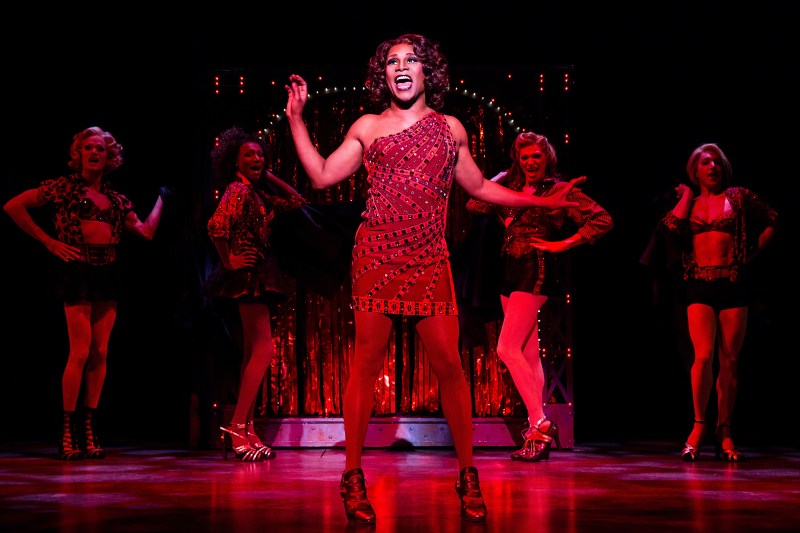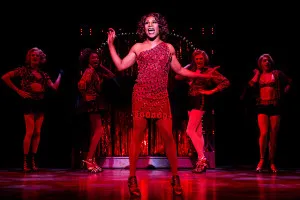
If there’s one thing Broadway still does better than anywhere else, it’s the musical. Some of them are so good and so popular that they run for years. As part of my special on the New York City theater scene, running this week, I caught the open run “Kinky Boots” at the Al Hirschfeld Theatre and “After Midnight,” the Tony Award winner for Best Choreography, which just closed at the Brooks Atkinson Theatre.
Although “Kinky Boots” — a musical based on the British film — has only been running for a little over a year, it’s so much fun and so well-executed, I could see it running for many more. This is a flawless production of a deeply flawed and already dated play: it looks and seems like progressive thinking, but it’s actually a troubling portrait of masculinity, cross-dressing and even race. Nevertheless, it’s quite something to see so many talented men dancing in flashy six-inch heels without ever wobbling.
The musical gets its name from the flashy high-heeled boots for men that a flailing men’s shoe factory in small-ish town in England starts to produce. The company is in dire financial straits and needs to capture a niche market to stay afloat so its employees don’t lose their jobs. Charlie Price (the very talented Andy Kelso), who inherited the factory from his father, gets the idea after running into the colorful and spunky Lola (Billy Porter), a black man in women’s clothing, who bemoans breaking yet another heel — women’s boots just aren’t built for the weight of a man. We meet Lola performing an introductory number “Land of Lola,” in sequins, alongside several other men in drag at the night club where she works.
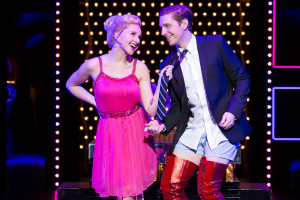
Although Charlie is in every way the straight man, it’s a tribute to Kelso (who took over the role from Stark Sands earlier this year) that he’s such a joy to watch and easy to like, despite his many, many missteps. He starts out planning to move to London with his obnoxious fiancé (Cortney Wolfson, in a thankless role), but finds himself tethered back home when his father (Stephen Berger) passes away, leaving him to run the shoe factory he never coveted. When one of his employees — and soon-to-be-love-interest — Lauren (Jeanna de Waal), gets him going down a path of a niche market, he decides on making kinky boots, a project that brings him out of his apathy. Lauren declares her potentially misguided interest in Charlie to the audience in a show-stopping number, sure to make de Waal a star, “The History of Wrong Guys.”
It’s in the first act, when everything is getting set up, that the show is pure joy and pure Broadway magic. Although I’m not much of a Cindy Lauper fan, who penned the songs for the show, they’re infectiously fun even if you don’t find yourself humming them as you leave the theater. When Lola explains, “Sex is in the Heel,” in her big number, it’s buoyant and very funny. We get seduced by Lola’s confidence just as much as Charlie is into turning around his entire business to cater to her niche market. In the show’s opening, full company number, “The Most Beautiful Thing in the World,” about the glory of shoes, you get the sense of the hustle and bustle of the shoe factory, while also figuring out who’s who and just what kind of a fun ride the show will be.
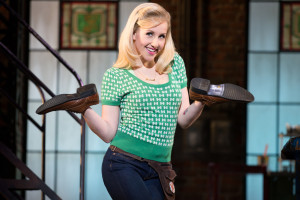
Director-Choreographer Jerry Mitchell uses the marvelous two-story set to tell two stories simultaneously: we see Charlie designing the shoes at the factory on the top level while Lola and crew sing about shoes on the ground level. It’s like the theatrical equivalent of a split screen. The sets also blur into one another seamlessly: an exit from one place is an entrance to another, often just by going up the stairs from one place leads to the office.
Eventually Charlie realizes he needs expert help in designing the kinky boots so he hires Lola. This is where the show gets unbearably preachy and starts to show its colors as a conventional and dated story. At the factory, Lola initially feels like she has to don men’s clothing despite feeling uncomfortable in it. She clashes with the chubby and close-minded Don (Daniel Stewart Sherman) who challenges Lola to prove her manliness in a boxing match — little does he know she trained as a professional boxer before taking on the night club — and when she shows mercy and lets him win, he realizes what’s happened. Lola gains Don’s respect, but it seems like the only reason Lola is given license — by Don and the show — to let her freak flag fly is because she’s already proven herself to be able to play the manly man with proficiency, but rejected that role.
Lola is clearly the most vibrant and interesting character on-stage. She aims to shock and be the center of attention and is generally just a riot. But her role is largely to teach the straight, white Charlie and Don about tolerance and acceptance so that they can grow, while Lola starts off fairly awesome and doesn’t change much throughout. Whether Lola is merely a cross-dresser or trans-gender is something the script never really decides on: other characters carelessly switch between referring to her as ‘he’ and ‘she,’ which is troubling and somewhat disrespectful. Lola may start out seeming like a “Strong Female Character,” but the play fails the modified Bechdel test when it comes to actually using her well. Nevertheless, the show certainly has good intentions: it’s just too bad that its mindset seems more 20th century than 21st.
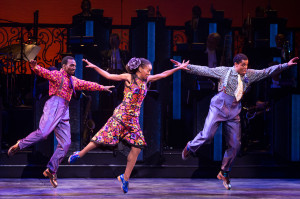
On the other side of the musical spectrum is “After Midnight,” a variety show meant to evoke the 1930s jazz scene in New York. Most musicals, except for some of the greats like “Cabaret” and “My Fair Lady,” have a flimsy plot as an excuse to tie the song-and-dance numbers together into some cohesive whole. You have to sit through the story to get to the good parts.
“After Midnight” dispenses almost entirely with plot, using only a few short monologues by emcee Dulé Hill to tie the various musical numbers together, performed by an incredibly talented all-black cast. As if that wasn’t enough of a draw, the house band is the virtuosic (and predominantly white) Jazz at Lincoln Center All-Stars, making the show worth catching for the music alone. They get to shine in the instrumental “Braggin’ in Brass,” where the entire bandstand, usually upstage, moves downstage so we can get a better view.
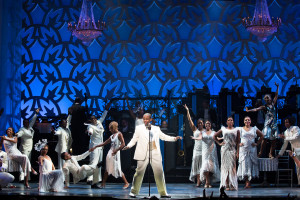
Given the accolades the show has received for its choreography, it’s no surprise that it hits its zenith in the big all-company dance numbers, like the glorious rendition of “The Skrontch” or the closing numbers “Cotton Club Stomp” and “Freeze and Melt,” in which the dancers freeze and melt, repeatedly, in sync with the lyrics.
The smaller dance numbers were at their best when they featured tap dancing, which ain’t the popular dance form it once was. There’s a lot of tap in the show, and it’s some of the best you’ll ever see on stage. Tap duo Daniel and Phillip set the tone for the high level of proficiency we can expect with the little ditty “Happy as the Day is Long” near the beginning, and then brought it up a notch with “Raisin’ the Rent.”
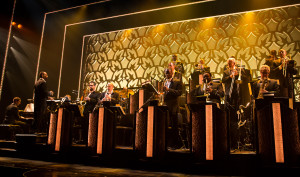
Eventually, though, all the numbers start to blur together. While celebrating the big band arrangements of Duke Ellington, the show has chosen precious few of his own compositions or those by other greats of his time. Instead, we get period-specific and fun but mostly forgettable tunes. The show’s a whole lot of fun while it’s going down, but it won’t leave much of a lingering impression aside from just how many talented singers and dancers it’s brought together.
